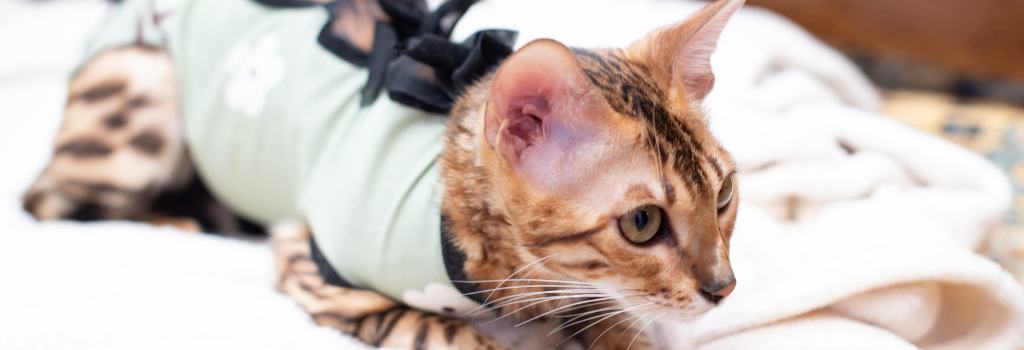Spaying & Neutering Your Cat: What You Should Know
We believe spaying or neutering is one of the most important choices you can make for your cat’s long-term health, comfort, and behavior. We approach these procedures with the same care and precision we would for our own pets. Whether you’ve just welcomed a new kitten or adopted an adult cat, we’re here to walk you through everything from timing to recovery.
What’s the Difference?
Spaying is the surgical removal of a female cat’s uterus and ovaries (ovariohysterectomy).
Neutering refers to the surgical removal of a male cat's testicles (castration).
Both procedures result in sterilization and prevent unwanted pregnancies, while also providing additional health benefits.
How does spaying or neutering impact the health and wellbeing of your cat?
Spaying or neutering has a significant impact on the health and wellbeing of your cat, from preventing pregnancy to positive behavioral changes. It’s a critical part of the AVMA’s guidelines for responsible pet ownership.
Spaying or neutering a cat impacts their well-being in the following ways:
- Prevents unwanted pregnancy
- Prevents diseases associated with mating
- Helps to avoid reproductive-related cancers later in life
- Helps to reduce the likelihood of injury and catfights as a result of wandering in search of a mate
- Eliminates urine marking behaviors in male cats
When Should My Cat Be Spayed or Neutered?
We typically recommend spaying or neutering your cat around six months of age, though the American Association of Feline Practitioners (AAFP) notes that five months is also appropriate. At this stage, your cat is still young but better able to handle anesthesia, and it’s early enough to prevent males from developing secondary sex traits and females from going into their first heat. Spaying before the first heat can also reduce the risk of certain health issues later in life. We will help you determine the ideal timing based on your cat’s needs.
Will it affect a cat's behavior?
Spaying or neutering can sometimes make your cat more mellow and help with aggressive tendencies if that is a problem. Males will no longer have the desire to mark your house, and they're not going to fight as much. The females’ desire to leave the house and breed is also eliminated by spaying.
How to Prepare for Surgery
Before surgery, it’s important to ensure your cat has an empty stomach, as anesthesia can cause nausea. Withhold food and water after 10:00 p.m. the night before the procedure. If your cat is usually outdoors, keep them inside the day before to ensure they're safe and ready for surgery. Most spays and neuters are outpatient procedures—your cat will come in that morning and go home the same day.

What to Expect on Surgery Day: Cat Spay
Your cat will be dropped off at 7:00 a.m. and will spend the day with us under the attentive care of our medical team. Please allow 15–20 minutes at drop-off to complete paperwork and speak with your pet’s surgery nurse. We want to ensure you feel fully informed, have all your questions answered, and leave confident in the care your pet will receive. Here’s what we include in our comprehensive surgical protocol:
- Pre-anesthetic bloodwork to screen organ function and ensure safe anesthesia
- IV catheter placement for administering fluids and medications during surgery • Endotracheal intubation to secure your cat’s airway and safely deliver anesthetic gases
- Careful monitoring of heart rate, oxygen levels, blood pressure, and temperature throughout the entire procedure. To learn more about anesthesia in cats: Click Here
- A thorough nail trim while your cat is under anesthesia, ensuring comfort without the stress
- Laser therapy is applied to the incision site to speed up healing and support a smoother recovery. To learn more about laser therapy: Click Here
- If you opt in, we’ll send you text updates throughout the day, so you’re never out of the loop. And of course, you can always call us directly for a real-time update on how your cat is doing.
- Suture removal 10 to 14 days after surgery if applicable
- A follow-up phone call the next business day from your surgery nurse to check on your pet.
After surgery, keep your cat calm and comfortable in a quiet space away from other pets and children. Monitor the incision site daily to ensure it's healing properly and not being irritated. Stitches are placed under the skin for added comfort, but healing still needs to be watched closely for the first 10–14 days. Most cats recover quickly, but some may be a little tired for a day or two after anesthesia.
Cat Neuter
A cat neuter is a relatively simple procedure. We sedate your cat and monitor them closely throughout, but unlike spays, neuters don’t require a breathing tube, IV catheter, or sutures. Most male cats recover quickly and are back to their normal selves in no time.
Why Choose Whittington Veterinary Clinic?
Because your pet deserves more than the basics. At Whittington Veterinary Clinic, we take every precaution to ensure your pet’s safety, comfort, and well-being during surgery. From the moment they arrive, they’re cared for like one of our own—with close monitoring, gentle handling, and constant attention. We take pride in offering safe, thorough surgical care and open communication throughout your dog’s spay or neuter experience. If you’re ready to schedule or have questions about what’s best for your pet, we’d be honored to help, please call us at (337) 893-8522.
